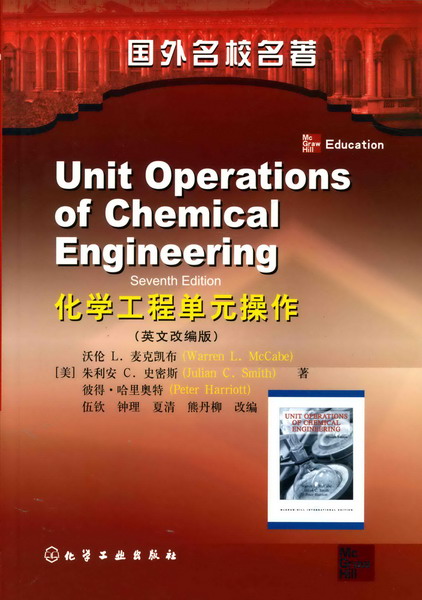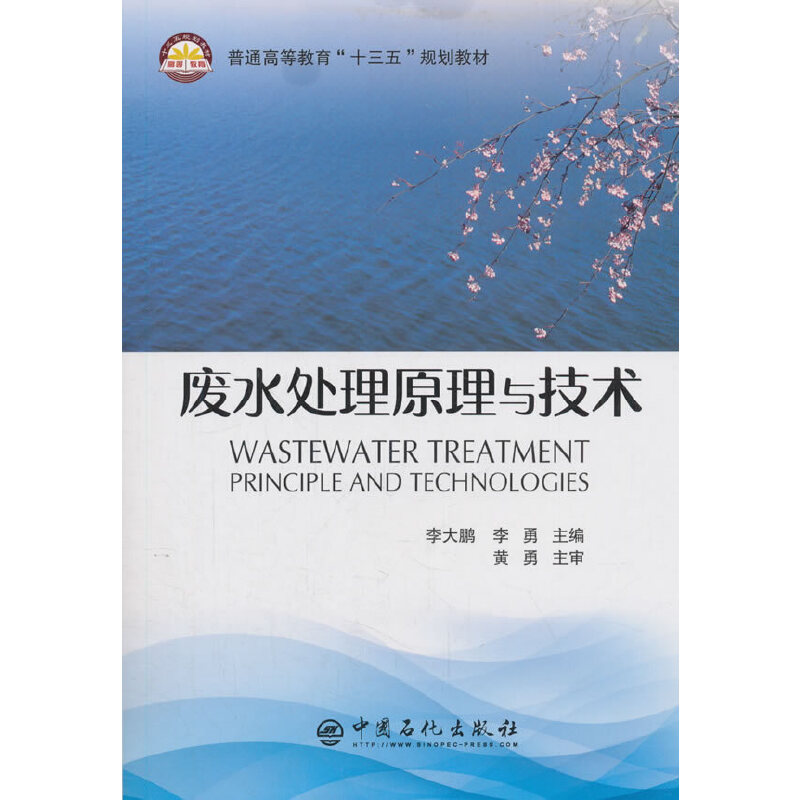无机及分析化学(英文版)
¥78.00定价
作者: 郭明
出版时间:2024-11
出版社:化学工业出版社
- 化学工业出版社
- 9787122447296
- 1版
- 529320
- 49250711-6
- 16开
- 2024-11
- 617
- 359
- ①O61②O65
- 化学类
- 本科
作者简介
目录
Chapter1 Dispersion system 1
1.1 Solution 2
1.1.1 Amount-of-substances and its units 2
1.1.2 Concentration of amount-of-substance 3
1.1.3 Amount-of-substance fraction 3
1.1.4 Molality 3
1.1.5 Mass fraction 4
1.2 General properties of dilute solution 4
1.2.1 Colligative properties 4
1.2.2 The vapour pressure of the solution decreases 4
1.2.3 Boiling point rise of solution 6
1.2.4 The freezing point of the solution decreases 7
1.2.5 Osmotic pressure of solution 9
1.3 Electrolyte solution 11
1.3.1 Electrolyte solution 11
1.3.2 Dissociation degree 11
1.3.3 Deviation of electrolyte colligative property 12
1.3.4 Introduction of strong electrolyte solution theory 12
1.3.5 Activity, activity coefficient and ionic strength 13
1.4 Colloidal solution 14
1.4.1 Dispersion degree and specific surface 14
1.4.2 Surface energy 15
1.4.3 Adsorption of gases by solids 15
1.4.4 Adsorption of solids in solution 16
1.4.5 Properties of sol 18
1.4.6 Causes of charged sol particles 21
1.4.7 Micelle structure 21
1.4.8 Stability and condensation of sol 22
1.4.9 Comparison of polymer solution and sol 24
Exercises 25
Chapter2 Fundamentals of chemical thermodynamics 27
2.1 Basic Concepts 27
2.1.1 System and environment 27
2.1.2 State and state function 27
2.1.3 Process and path 28
2.1.4 Heat and work 28
2.1.5 Internal energy 28
2.2 Thermal effect of chemical reaction 29
2.2.1 The first law of thermodynamics 29
2.2.2 Concepts of reaction heat at constant volume, reaction heat at constant pressure and enthalpy 29
2.2.3 Thermochemical equation 31
2.2.4 Hess’s Law 31
2.2.5 Formation enthalpy 33
2.3 Entropy and entropy increase principle 34
2.3.1 Spontaneity of chemical reactions 34
2.3.2 Entropy 35
2.3.3 Standard molar entropy 36
2.4 Gibbs function and chemical reaction direction 38
2.4.1 Gibbs function 38
2.4.2 Standard generated Gibbs function 39
2.4.3 Relationship between ΔG and temperature 40
Exercises 41
Chapter3 Chemical reaction rate and chemical equilibrium 43
3.1 Chemical reaction rate 43
3.1.1 Reaction rate 43
3.1.2 Mass action law and rate equation 46
3.1.3 Rate theory of chemical reaction 51
3.2 Catalyst 54
3.2.1 Definition of catalyst 54
3.2.2 Principle and method of catalysis 54
3.3 Reversible reaction and chemical equilibrium 56
3.3.1 Reversible reaction 56
3.3.2 Equilibrium constant 57
3.3.3 Relationship between standard equilibrium constant and Gibbs free energy 59
3.3.4 Multiple equilibrium rules 62
3.3.5 The movement of chemical equilibrium 63
Exercises 65
Chapter4 The Structure of the Chemical Substance 69
4.1 Quantum mechanical models of atom 69
4.1.1 Wave-particle duality of microscopic particles 69
4.1.2 Heisenberg uncertainty relationship 70
4.1.3 Wave functions and atomic orbitals 71
4.1.4 Electron cloud and radial distribution 72
4.2 Motion state of extranuclear electrons 74
4.2.1 Four quantum numbers 74
4.2.2 Electron arrangement outside the nucleus 76
4.3 Electron layer of atoms and periodic table of elements 82
4.3.1 Electron layer structure and period 82
4.3.2 Periodicity of element properties 83
4.4 Covalent bond 86
4.4.1 Valence bond theory 87
4.4.2 Hybrid orbital theory 92
4.5 Intermolecular forces and hydrogen bonds 97
4.6 Crystal structure 101
4.6.1 Crystal characteristics 101
4.6.2 Types of crystals 102
Exercises 105
Chapter5 Chemical analysis 108
5.1 Overview of Analytical Chemistry 108
5.1.1 Tasks and functions of Analytical Chemistry 108
5.1.2 Classification of analytical methods 109
5.1.3 General steps of quantitative analysis 111
5.2 Errors in quantitative analysis 115
5.2.1 Sources and classification of errors 116
5.2.2 Expression of error 117
5.2.3 Methods to improve the accuracy of analysis results 122
5.2.4 Data processing of analysis results 123
5.3 Significant figures and operation rules 129
5.3.1 Significant figures 129
5.3.2 Rounding off of significant figures 130
5.3.3 Operation rules of significant numbers 130
5.4 Titration analysis 132
5.4.1 Overview of titration analysis 132
5.4.2 Classification of titration analysis 132
5.4.3 Conditions and methods of titration reaction 133
5.4.4 Standard solution and reference material 134
5.4.5 Calculation in titration analysis 136
Exercises 138
Chapter6 Acid-base reaction balance and acid-base titration 141
6.1 Acid base proton theory 141
6.1.1 Definition of acid base 141
6.1.2 The conjugate relationship of acid and alkali and the common appearance of acid base pair 142
6.1.3 Essence of acid-base reaction 143
6.1.4 Proton self-transfer of water and pH value of solution 145
6.2 Acid base balance 146
6.2.1 Treatment method of acid-base balance in solution 146
6.2.2 Dissociation equilibrium of weak acid and weak base in solution 148
6.2.3 Same ion effect and salt effect 149
6.3 Calculation of concentration in acid-base balance 150
6.3.1 Calculation of pH value of acid-base solution 150
6.3.2 Distribution of acid-base components in aqueous solution 157
6.4 Acid base buffer solution 161
6.4.1 Buffering principle 162
6.4.2 Calculation of pH value of buffer solution 162
6.4.3 Buffer capacity and buffer range 163
6.4.4 Preparation of buffer solution 164
6.5 Acid base indicator 165
6.5.1 Discoloration principle of acid base indicator 165
6.5.2 Discoloration range of acid-base indicator 166
6.5.3 Main factors affecting the range of acid-base indicator 168
6.5.4 Mixed indicators 169
6.6 Basic principle of acid base titration 170
6.6.1 Mutual titration of strong acid and strong base 171
6.6.2 Titration of single weak acid (base) with strong base (acid) 174
6.6.3 Titration of polybasic acids and bases 178
6.7 Application of acid base titration 182
6.7.1 Preparation and calibration of acid base standard solution 182
6.7.2 Application examples 184
Exercises 187
Chapter7 Precipitation dissolution equilibrium and precipitation analysis 191
7.1 Solubility product constant and solubility product rule 191
7.1.1 Solubility 191
7.1.2 Solubility product constant 191
7.1.3 Conversion between solubility product and solubility 193
7.1.4 Common ion effect and salt effect 194
7.1.5 Rule of solubility product 195
7.2 Application of solubility product rule 196
7.2.1 Formation of precipitation 196
7.2.2 Fractional precipitation 198
7.2.3 Dissolution of precipitates 199
7.2.4 Transformation of precipitation 202
7.3 Precipitation titration method 203
7.3.1 Overview of precipitation titration 203
7.3.2 Determination of end point by precipitation titration 204
7.4 Gravimetric method 208
7.4.1 Overview of precipitation gravimetric analysis 208
7.4.2 Factors affecting precipitation purity 209
7.4.3 Selection of precipitation conditions 210
7.4.4 Filtration and washing of precipitates 211
7.4.5 Drying or burning of precipitates 212
7.4.6 Calculation of analysis results 212
Exercises 212
Chapter8 Redox Reaction Balance and Redox Titration 214
8.1 The basic concept of redox reaction 214
8.1.1 Oxidation number 214
8.1.2 Redox reaction 215
8.1.3 Redox half reaction and redox electric pairs 217
8.2 Balancing redox reaction equation 217
8.2.1 Oxidation number method 217
8.2.2 Ion-electron method 218
8.3 Galvanic cell and electrode potential 220
8.3.1 Galvanic cell and redox reaction 220
8.3.2 Electrode potential 222
8.3.3 Theoretical calculation of electrode potential (the relationship between electromotive force and ΔrGm) 225
8.4 Factors affecting electrode potential and application of electrode potential 227
8.4.1 Nernst equation and its application 227
8.4.2 Factors affecting electrode potential 229
8.5 Element potential diagram and its application 232
8.5.1 Element potential diagram 232
8.5.2 Application of element potential diagrams 232
8.6 Redox titration 234
8.6.1 Overview 234
8.6.2 Redox titration curve 239
8.6.3 Redox titration indicator 242
8.7 Redox titration method in common use 244
8.7.1 Potassium permanganate method 245
8.7.2 Potassium dichromate method 248
8.7.3 Iodometry 251
Exercises 255
Chapter9 Coordination Reaction Equilibrium and Coordination Titration 261
9.1 Composition and nomenclature of coordination compound 261
9.1.1 Composition of coordination compound 261
9.1.2 Nomenclature of coordination compound 263
9.2 Valence bond theory of coordination compound 265
9.2.1 Valence bond theory 265
9.2.2 Crystal field theory 267
9.3 Coordination equilibrium 268
9.3.1 Coordination equilibrium constant 268
9.3.2 Movement of coordination equilibrium 271
9.4 Chelate 278
9.4.1 Definition of chelates 278
9.4.2 Chelating agent 278
9.4.3 Chelate effect 279
9.5 The complexes of EDTA with metal ions and the stable 280
9.5.1 EDTA dissociation equilibrium 280
9.5.2 The characteristics of the chelate of EDTA and metal ions 281
9.5.3 Main factors affecting the stability of EDTA complexes 282
9.5.4 Conditional stability constants of EDTA complexes 284
9.6 Coordination titration 285
9.6.1 Coordination titration curve 285
9.6.2 The condition of accurately titrating a metal 287
9.6.3 Acidity range of coordination titration 287
9.7 Metal indicator 289
9.7.1 Principle of action of metal indicator 289
9.7.2 Requirements for metal indicator 290
9.7.3 Common metal indicators 290
9.7.4 Selection of metal indicator 291
9.7.5 Problems that should be paid attention to during the use of metal indicator 291
9.8 Classification of coordination titration and elimination of interfering ions 292
9.8.1 Classification of coordination titration 292
9.8.2 Elimination of titration interference 293
9.9 Application of coordination titration 295
9.9.1 Preparation and calibration of EDTA standard solution 295
9.9.2 Application examples 296
Exercises 297
Chapter 10 Brief Content of Elemental Chemistry 300
10.1 Halogen 300
10.1.1 Overview 300
10.1.2 Halogen elements 301
10.1.3 Hydrogen halides and hydrohalides 302
10.1.4 Halide 303
10.1.5 Oxyacids and salts of halogens 303
10.2 Oxygen 305
10.2.1 Oxygen and ozone 305
10.2.2 Hydrogen peroxide 306
10.3 Nitrogen and phosphorus 307
10.3.1 Nitrogen and its important compounds 307
10.3.2 Important compounds of phosphorus 309
10.4 Copper, silver, zinc, cadmium and mercury 311
10.4.1 Important compounds of copper and silver 312
10.4.2 Important compounds of zinc, cadmium and mercury 313
10.5 Chromium, molybdenum and manganese 314
10.5.1 Chromium and molybdenum compounds 315
10.5.2 Manganese compounds 316
10.6 Iron and cobalt 317
10.6.1 Iron compounds 317
10.6.2 Cobalt compounds 318
Exercises 319
Chapter 11 Spectrophotometric method 320
11.1 Selective absorption of light by substances 320
11.1.1 Electromagnetic spectrum 320
11.1.2 The interaction between light and matter 321
11.1.3 Adsorption curve 322
11.1.4 Characteristics of spectrophotometry 323
11.2 Law of absorption of light 324
11.2.1 Lambert-Beer’s law 324
11.2.2 Molar absorptivity 325
11.2.3 The reason for deviating from Lambert-Beer’s law 326
11.3 Spectrophotometer 328
11.4 Color reaction and selection of color conditions 330
11.4.1 Selection of chromogenic reaction 331
11.4.2 Selection of chromogenic conditions 331
11.5 Selection of conditions for absorbance determination 333
11.5.1 Selection of absorbing light range 333
11.5.2 Selection of reference solution 335
11.5.3 Interference and elimination methods 335
11.6 Application of spectrophotometry 336
11.6.1 Determination of single component 336
11.6.2 Multicomponent quantitative method 337
11.6.3 Differential spectrophotometry 338
Exercises 339
References 342
The appendix 343
1.1 Solution 2
1.1.1 Amount-of-substances and its units 2
1.1.2 Concentration of amount-of-substance 3
1.1.3 Amount-of-substance fraction 3
1.1.4 Molality 3
1.1.5 Mass fraction 4
1.2 General properties of dilute solution 4
1.2.1 Colligative properties 4
1.2.2 The vapour pressure of the solution decreases 4
1.2.3 Boiling point rise of solution 6
1.2.4 The freezing point of the solution decreases 7
1.2.5 Osmotic pressure of solution 9
1.3 Electrolyte solution 11
1.3.1 Electrolyte solution 11
1.3.2 Dissociation degree 11
1.3.3 Deviation of electrolyte colligative property 12
1.3.4 Introduction of strong electrolyte solution theory 12
1.3.5 Activity, activity coefficient and ionic strength 13
1.4 Colloidal solution 14
1.4.1 Dispersion degree and specific surface 14
1.4.2 Surface energy 15
1.4.3 Adsorption of gases by solids 15
1.4.4 Adsorption of solids in solution 16
1.4.5 Properties of sol 18
1.4.6 Causes of charged sol particles 21
1.4.7 Micelle structure 21
1.4.8 Stability and condensation of sol 22
1.4.9 Comparison of polymer solution and sol 24
Exercises 25
Chapter2 Fundamentals of chemical thermodynamics 27
2.1 Basic Concepts 27
2.1.1 System and environment 27
2.1.2 State and state function 27
2.1.3 Process and path 28
2.1.4 Heat and work 28
2.1.5 Internal energy 28
2.2 Thermal effect of chemical reaction 29
2.2.1 The first law of thermodynamics 29
2.2.2 Concepts of reaction heat at constant volume, reaction heat at constant pressure and enthalpy 29
2.2.3 Thermochemical equation 31
2.2.4 Hess’s Law 31
2.2.5 Formation enthalpy 33
2.3 Entropy and entropy increase principle 34
2.3.1 Spontaneity of chemical reactions 34
2.3.2 Entropy 35
2.3.3 Standard molar entropy 36
2.4 Gibbs function and chemical reaction direction 38
2.4.1 Gibbs function 38
2.4.2 Standard generated Gibbs function 39
2.4.3 Relationship between ΔG and temperature 40
Exercises 41
Chapter3 Chemical reaction rate and chemical equilibrium 43
3.1 Chemical reaction rate 43
3.1.1 Reaction rate 43
3.1.2 Mass action law and rate equation 46
3.1.3 Rate theory of chemical reaction 51
3.2 Catalyst 54
3.2.1 Definition of catalyst 54
3.2.2 Principle and method of catalysis 54
3.3 Reversible reaction and chemical equilibrium 56
3.3.1 Reversible reaction 56
3.3.2 Equilibrium constant 57
3.3.3 Relationship between standard equilibrium constant and Gibbs free energy 59
3.3.4 Multiple equilibrium rules 62
3.3.5 The movement of chemical equilibrium 63
Exercises 65
Chapter4 The Structure of the Chemical Substance 69
4.1 Quantum mechanical models of atom 69
4.1.1 Wave-particle duality of microscopic particles 69
4.1.2 Heisenberg uncertainty relationship 70
4.1.3 Wave functions and atomic orbitals 71
4.1.4 Electron cloud and radial distribution 72
4.2 Motion state of extranuclear electrons 74
4.2.1 Four quantum numbers 74
4.2.2 Electron arrangement outside the nucleus 76
4.3 Electron layer of atoms and periodic table of elements 82
4.3.1 Electron layer structure and period 82
4.3.2 Periodicity of element properties 83
4.4 Covalent bond 86
4.4.1 Valence bond theory 87
4.4.2 Hybrid orbital theory 92
4.5 Intermolecular forces and hydrogen bonds 97
4.6 Crystal structure 101
4.6.1 Crystal characteristics 101
4.6.2 Types of crystals 102
Exercises 105
Chapter5 Chemical analysis 108
5.1 Overview of Analytical Chemistry 108
5.1.1 Tasks and functions of Analytical Chemistry 108
5.1.2 Classification of analytical methods 109
5.1.3 General steps of quantitative analysis 111
5.2 Errors in quantitative analysis 115
5.2.1 Sources and classification of errors 116
5.2.2 Expression of error 117
5.2.3 Methods to improve the accuracy of analysis results 122
5.2.4 Data processing of analysis results 123
5.3 Significant figures and operation rules 129
5.3.1 Significant figures 129
5.3.2 Rounding off of significant figures 130
5.3.3 Operation rules of significant numbers 130
5.4 Titration analysis 132
5.4.1 Overview of titration analysis 132
5.4.2 Classification of titration analysis 132
5.4.3 Conditions and methods of titration reaction 133
5.4.4 Standard solution and reference material 134
5.4.5 Calculation in titration analysis 136
Exercises 138
Chapter6 Acid-base reaction balance and acid-base titration 141
6.1 Acid base proton theory 141
6.1.1 Definition of acid base 141
6.1.2 The conjugate relationship of acid and alkali and the common appearance of acid base pair 142
6.1.3 Essence of acid-base reaction 143
6.1.4 Proton self-transfer of water and pH value of solution 145
6.2 Acid base balance 146
6.2.1 Treatment method of acid-base balance in solution 146
6.2.2 Dissociation equilibrium of weak acid and weak base in solution 148
6.2.3 Same ion effect and salt effect 149
6.3 Calculation of concentration in acid-base balance 150
6.3.1 Calculation of pH value of acid-base solution 150
6.3.2 Distribution of acid-base components in aqueous solution 157
6.4 Acid base buffer solution 161
6.4.1 Buffering principle 162
6.4.2 Calculation of pH value of buffer solution 162
6.4.3 Buffer capacity and buffer range 163
6.4.4 Preparation of buffer solution 164
6.5 Acid base indicator 165
6.5.1 Discoloration principle of acid base indicator 165
6.5.2 Discoloration range of acid-base indicator 166
6.5.3 Main factors affecting the range of acid-base indicator 168
6.5.4 Mixed indicators 169
6.6 Basic principle of acid base titration 170
6.6.1 Mutual titration of strong acid and strong base 171
6.6.2 Titration of single weak acid (base) with strong base (acid) 174
6.6.3 Titration of polybasic acids and bases 178
6.7 Application of acid base titration 182
6.7.1 Preparation and calibration of acid base standard solution 182
6.7.2 Application examples 184
Exercises 187
Chapter7 Precipitation dissolution equilibrium and precipitation analysis 191
7.1 Solubility product constant and solubility product rule 191
7.1.1 Solubility 191
7.1.2 Solubility product constant 191
7.1.3 Conversion between solubility product and solubility 193
7.1.4 Common ion effect and salt effect 194
7.1.5 Rule of solubility product 195
7.2 Application of solubility product rule 196
7.2.1 Formation of precipitation 196
7.2.2 Fractional precipitation 198
7.2.3 Dissolution of precipitates 199
7.2.4 Transformation of precipitation 202
7.3 Precipitation titration method 203
7.3.1 Overview of precipitation titration 203
7.3.2 Determination of end point by precipitation titration 204
7.4 Gravimetric method 208
7.4.1 Overview of precipitation gravimetric analysis 208
7.4.2 Factors affecting precipitation purity 209
7.4.3 Selection of precipitation conditions 210
7.4.4 Filtration and washing of precipitates 211
7.4.5 Drying or burning of precipitates 212
7.4.6 Calculation of analysis results 212
Exercises 212
Chapter8 Redox Reaction Balance and Redox Titration 214
8.1 The basic concept of redox reaction 214
8.1.1 Oxidation number 214
8.1.2 Redox reaction 215
8.1.3 Redox half reaction and redox electric pairs 217
8.2 Balancing redox reaction equation 217
8.2.1 Oxidation number method 217
8.2.2 Ion-electron method 218
8.3 Galvanic cell and electrode potential 220
8.3.1 Galvanic cell and redox reaction 220
8.3.2 Electrode potential 222
8.3.3 Theoretical calculation of electrode potential (the relationship between electromotive force and ΔrGm) 225
8.4 Factors affecting electrode potential and application of electrode potential 227
8.4.1 Nernst equation and its application 227
8.4.2 Factors affecting electrode potential 229
8.5 Element potential diagram and its application 232
8.5.1 Element potential diagram 232
8.5.2 Application of element potential diagrams 232
8.6 Redox titration 234
8.6.1 Overview 234
8.6.2 Redox titration curve 239
8.6.3 Redox titration indicator 242
8.7 Redox titration method in common use 244
8.7.1 Potassium permanganate method 245
8.7.2 Potassium dichromate method 248
8.7.3 Iodometry 251
Exercises 255
Chapter9 Coordination Reaction Equilibrium and Coordination Titration 261
9.1 Composition and nomenclature of coordination compound 261
9.1.1 Composition of coordination compound 261
9.1.2 Nomenclature of coordination compound 263
9.2 Valence bond theory of coordination compound 265
9.2.1 Valence bond theory 265
9.2.2 Crystal field theory 267
9.3 Coordination equilibrium 268
9.3.1 Coordination equilibrium constant 268
9.3.2 Movement of coordination equilibrium 271
9.4 Chelate 278
9.4.1 Definition of chelates 278
9.4.2 Chelating agent 278
9.4.3 Chelate effect 279
9.5 The complexes of EDTA with metal ions and the stable 280
9.5.1 EDTA dissociation equilibrium 280
9.5.2 The characteristics of the chelate of EDTA and metal ions 281
9.5.3 Main factors affecting the stability of EDTA complexes 282
9.5.4 Conditional stability constants of EDTA complexes 284
9.6 Coordination titration 285
9.6.1 Coordination titration curve 285
9.6.2 The condition of accurately titrating a metal 287
9.6.3 Acidity range of coordination titration 287
9.7 Metal indicator 289
9.7.1 Principle of action of metal indicator 289
9.7.2 Requirements for metal indicator 290
9.7.3 Common metal indicators 290
9.7.4 Selection of metal indicator 291
9.7.5 Problems that should be paid attention to during the use of metal indicator 291
9.8 Classification of coordination titration and elimination of interfering ions 292
9.8.1 Classification of coordination titration 292
9.8.2 Elimination of titration interference 293
9.9 Application of coordination titration 295
9.9.1 Preparation and calibration of EDTA standard solution 295
9.9.2 Application examples 296
Exercises 297
Chapter 10 Brief Content of Elemental Chemistry 300
10.1 Halogen 300
10.1.1 Overview 300
10.1.2 Halogen elements 301
10.1.3 Hydrogen halides and hydrohalides 302
10.1.4 Halide 303
10.1.5 Oxyacids and salts of halogens 303
10.2 Oxygen 305
10.2.1 Oxygen and ozone 305
10.2.2 Hydrogen peroxide 306
10.3 Nitrogen and phosphorus 307
10.3.1 Nitrogen and its important compounds 307
10.3.2 Important compounds of phosphorus 309
10.4 Copper, silver, zinc, cadmium and mercury 311
10.4.1 Important compounds of copper and silver 312
10.4.2 Important compounds of zinc, cadmium and mercury 313
10.5 Chromium, molybdenum and manganese 314
10.5.1 Chromium and molybdenum compounds 315
10.5.2 Manganese compounds 316
10.6 Iron and cobalt 317
10.6.1 Iron compounds 317
10.6.2 Cobalt compounds 318
Exercises 319
Chapter 11 Spectrophotometric method 320
11.1 Selective absorption of light by substances 320
11.1.1 Electromagnetic spectrum 320
11.1.2 The interaction between light and matter 321
11.1.3 Adsorption curve 322
11.1.4 Characteristics of spectrophotometry 323
11.2 Law of absorption of light 324
11.2.1 Lambert-Beer’s law 324
11.2.2 Molar absorptivity 325
11.2.3 The reason for deviating from Lambert-Beer’s law 326
11.3 Spectrophotometer 328
11.4 Color reaction and selection of color conditions 330
11.4.1 Selection of chromogenic reaction 331
11.4.2 Selection of chromogenic conditions 331
11.5 Selection of conditions for absorbance determination 333
11.5.1 Selection of absorbing light range 333
11.5.2 Selection of reference solution 335
11.5.3 Interference and elimination methods 335
11.6 Application of spectrophotometry 336
11.6.1 Determination of single component 336
11.6.2 Multicomponent quantitative method 337
11.6.3 Differential spectrophotometry 338
Exercises 339
References 342
The appendix 343








